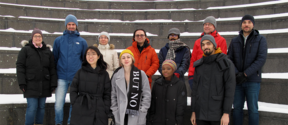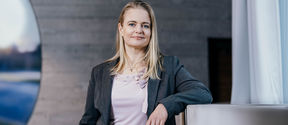Nuclear Materials and Engineering (NuME)
The Nuclear Materials and Engineering group employs computational methods to study radiation induced processes and damage formation in materials.


How did your academic career begin?
I began my research journey by investigating the interaction of intense laser pulses with liquids, exploring potential applications in this area. Although I was always fascinated by the world of light, I felt there was something missing in a way we look at the perturbed matter – we never turned to the plasma physics theory to describe it. So, I decided to delve into the basics of plasma physics, which much later led me to the exciting field of fusion energy. I have always believed that addressing our energy needs is vital and is a worthwhile area to study.
When my fellowship with Aalto University's Optics and Photonics group ended in the summer of '22, I sought a full-time PhD position. Joining Andrea Sand’s team was one of my options, although I was not entirely confident in my fit for the role due to the different background I had. However, I believe what greatly bolstered my chances was my broad scientific awareness and the research experience I gained during my Bachelor's and Master's studies in Saint-Petersburg. The research culture there differs significantly from that of Europe; I was exposed to various research practices early on, and by the time I arrived at Aalto, I had a portfolio of papers published in good journals, participation in several international conferences, and a few stipends on the list. Despite some nervousness about switching research fields, I was genuinely happy to secure a position in Andrea’s Nuclear Materials and Engineering research group.
Now that you have secured a position in the NuME group, what has been the focus of your research?
While I am not directly solving the energy crisis, my work focuses on the materials used in nuclear reactors, which is just as important. It is a challenging puzzle, but the community is making a big progress through both theory and experiments. Our role in solving this puzzle is a multiscale simulation of radiation damage in fusion-relevant materials.
My progress in the first year and the importance of my topic helped me secure a one-year PhD grant from the Vilho, Yrjö, and Kalle Väisälä fund. My project is now focused quite strongly on figuring out how electronic effects impact the overall material damage. Specifically, this research delves into how light ions, common transmutation products, lose energy in the structural materials of nuclear devices, such as tungsten and iron. Unlike regular collisions, the electronic excitations are a bit trickier to grasp because they play by quantum mechanics rules. To tackle this, we start with ab initio simulations to accurately capture electron-ion interactions that occur in femtoseconds. The obtained data helps us transition to larger-scale simulations, where we explore phenomena like sputtering and defect generation. Ultimately, we aim to contribute into filling the existing gap in damage modeling by integrating a better understanding of how kinetic energy is partitioned between damage energy and electronic losses, potentially increasing the predictive accuracy within materials science and engineering. We are lucky to have collaboration with experimental team from Uppsala University, which allows us to validate our findings and ensure we are on the right track.
What motivates you in your work?
As a PhD student, it is important for me to both work on meaningful projects and find joy in what I do. Personally, I find the processes that unfold on the ultrashort timescale the most exciting. While these events occur too rapidly for direct observation, their consequences may become visible on larger scales. However, my curiosity certainly extends beyond that. Being part of the fusion community is rewarding, and in my future career, I am eager to explore various opportunities within the field.
How did you arrive at Aalto?
I relocated from Russia to Finland to pursue a double-degree PhD, but the onset of war dashed those plans. However, despite the initial setback, my journey took a positive turn after joining the Aalto University community. Here, I had the privilege of meeting great people and gaining fresh perspectives on various topics that I had not considered before. And when it comes to NuME group – it is incredibly diverse, comprising members from eight different countries. This multicultural environment fosters daily exchanges about cultural and societal nuances. Working in such a setting has taught me valuable lessons in understanding, empathy, and simply being a better human.
Andrea, our group leader, cultivates a safe and flexible atmosphere where everyone feels comfortable to discuss not only work-related matters but also broader career aspirations and personal challenges. This support system proved invaluable to me, especially during a period of anxiety and uncertainty. It is reassuring to know that help is readily available, both from colleagues and from the resources provided by Aalto University.

The Nuclear Materials and Engineering group employs computational methods to study radiation induced processes and damage formation in materials.

Andrea Sand receives significant funding from European Research Council for research that can open doors for next-generation materials in electronics


